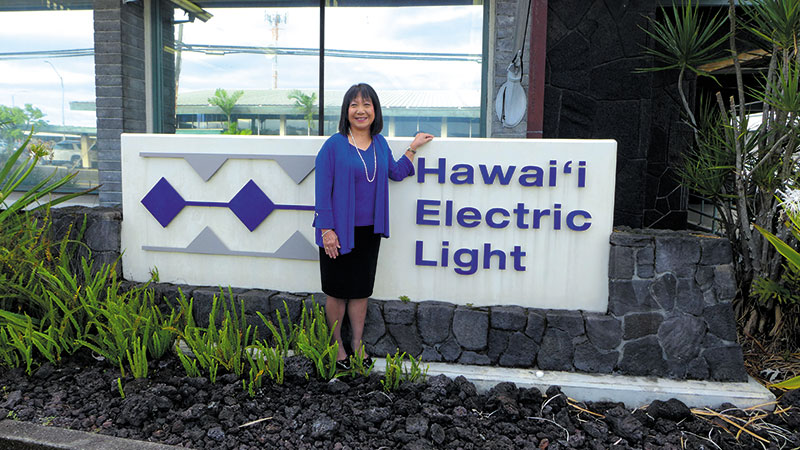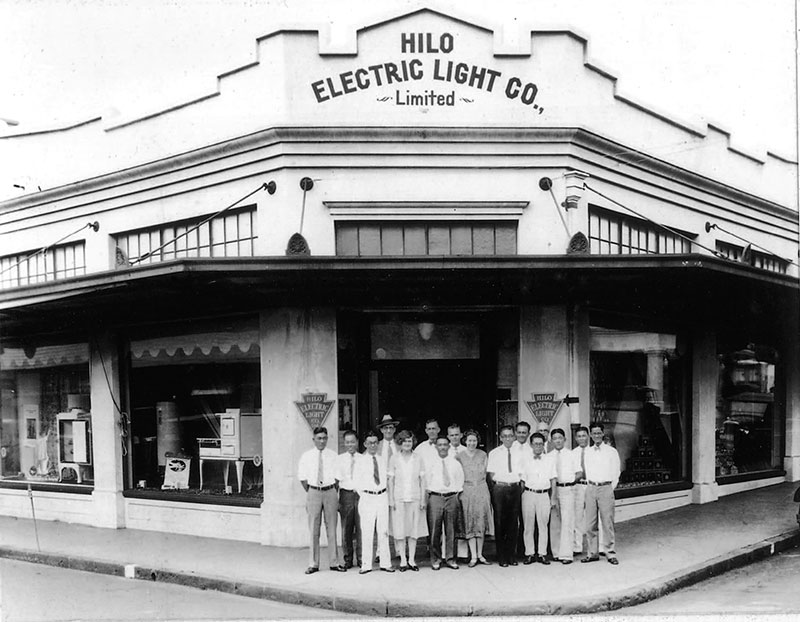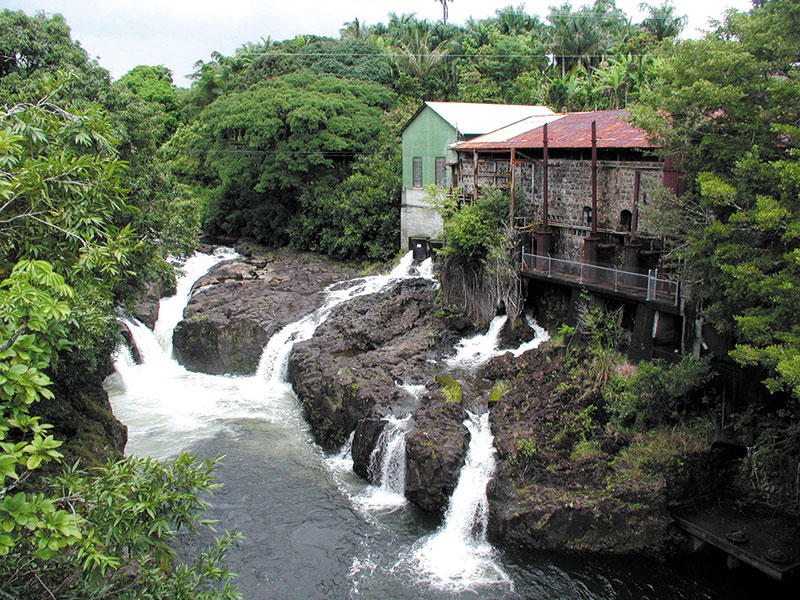Shining A Light On 125 Years

Sharon Suzuki, president of Maui County and Hawai‘i Island Utilities, at Hawai‘i Electric Light’s main office. KATIE YOUNG YAMANAKA PHOTO
More than a century ago, a small, water-driven dynamo installed on Hilo Boarding School’s irrigation ditch produced just enough electricity to power 12 bare light bulbs from dusk until 10 p.m. This was the beginning of what would become Hawai‘i Electric Light, which celebrates its 125th anniversary on the Big Island this month.
Today, Hawai‘i Electric Light employs 300 residents and provides electricity for 86,000 customers from a diverse mix of resources, including hydro, solar, wind and biofuels, with the goal of a 100 percent clean energy future.
In honor of a century-and-a-quarter of service, Hawai‘i Electric Light will hold two special events across the island. The first runs from 8 to 10 a.m. Thursday, Dec. 5, on Kalākaua Street in downtown Hilo, outside the original Hilo Electric Light Co. headquarters. There, guests can enjoy light refreshments, historic displays and commemorative anniversary giveaways. (Lower Kalākaua Street will be closed from 6:30 to 10 a.m. for this event.)
In Kona, a free outdoor movie night featuring The Grinch will be held Saturday, Dec. 7, at Kona Commons Shopping Center. The event starts at 5 p.m., with the film beginning an hour later. In addition to the movie, there will be prize drawings, informational booths, visits with Santa and free popcorn. Picnic chairs and blankets are welcome, but, coolers, alcohol and outside food are not permitted. New, unwrapped toys will be collected for the Toys for Tots program benefiting island keiki, as well.

Hilo Electric Light Co.’s original headquarters was on the corner of Kalākaua Street and Kamehameha Avenue
“Hawai‘i Electric Light and our employees are deeply connected to the Big Island community,” says Sharon Suzuki, president of Maui County and Hawai‘i Island Utilities. “Employees work here and raise their families here — some for many generations. There is a deep sense of pride and commitment to serve our customers.”
Suzuki says the 125th anniversary event is important because it celebrates the people who have helped the company reach this milestone year.
“It’s important for us to thank our customers and community for their support,” she says. “We also want to thank our partners for collaborating with us to make the Big Island one of the best places to live and work. Last, but not least, we want to thank our employees and retirees because they’re the heart of Hawai‘i Electric Light.”
The company’s employees especially shine during crises, she says, like hurricanes, earthquakes, tsunamis and volcanic eruptions, of which Hawai‘i Island has endured its fair share in recent years.
“Every employee is trained and expected to respond in emergency situations,” she says. “They’re hard at work before, during and after an incident. This means long hours and extended periods of time away from their families.”
Right now, Suzuki says Hawai‘i Electric Light’s most important focus is meeting the state of Hawai‘i’s goal of a 100 percent clean energy future by 2045.
“We have detailed plans to create a 21st-century grid that’s capable of integrating increasing amounts of renewable energy,” explains Suzuki.
The company is also seeking more green energy projects. Earlier this year, two new solar projects in Waikoloa were approved by the Public Utilities Commission and are expected to come online by 2022.

The Pu‘u‘eo Hydroelectric Plant, still in operation today, was constructed in 1901. At the time, 100 percent of the electricity powering the island came from a clean, renewable resource: run of the river hydro. PHOTOS COURTESY HAWAI’I ELECTRIC LIGHT
“And we’re not stopping there,” she says. “The company has issued another Request for Proposals that includes up to 203 megawatts of solar plus storage for Hawai‘i Island. More than 75 proposals for projects statewide were received and are under review.”
Suzuki says that ultimately, Hawai‘i Electric Light wants to improve the quality of life for everyone in the community by sharing ideas and working together to meet the state’s renewable energy milestones, strengthen the economy and help communities become more resilient to natural disasters.
Hawai‘i Electric Light past president Jay Ignacio (2008-19), who retired earlier this year, says he is proud of the company’s success in integrating increasing amounts of renewable energy.
“In 2008, our Renewable Portfolio Standard was 35.4 percent, and by 2017 it was 56.6 percent,” he says. “In the earlier years of the renewable energy expansion, we did not know how many photovoltaic systems could be connected to our distribution circuits. There were concerns of fluctuating voltages, equipment overloads, circuits disconnecting from the rest of the power system and continuing to operate in an uncontrolled fashion, and circuits failing to automatically turn off when a problem occurred, such as a fallen wire. These were valid concerns for the safety of customers and their equipment.”
Hawai‘i was leading the way in this area, so there were no textbooks or manuals on how to do it, Ignacio explains.
“I’ve seen the company use technology to overcome a lot of the challenges we faced to maintain the level of reliability as we change our generation mix to incorporate more solar, wind, hydro and geothermal,” he adds. “Most people don’t realize how progressive Hawai‘i Electric Light is with protective relays, communication systems, system operations and renewable energy generation. There’s been a lot of work done to incorporate more renewables while maintaining reliability.”
Ignacio says he’d like to see the company continue to pursue more low-cost renewables without compromising power system reliability in the future.
“That balance must be understood and maintained,” he says. “We need to pursue the right set of additional renewables — low cost and home-grown — so that we’re not vulnerable to fuel supply disruptions.”
Despite the loss of the Puna Geothermal Venture last year, Hawai‘i Island remains a renewable energy leader with 44 percent of electricity sales coming from renewable resources like solar, wind and hydro.
“Integrating increasing amounts of variable renewable energy to the grid is challenging,” Suzuki explains. “The sun doesn’t always shine, and the wind doesn’t always blow at a constant rate. The challenge is how to safely integrate renewable energy and ensure stable electric service to our customers. Over the years, we’ve been able to develop innovative solutions to increase visibility and control on the grid to integrate more renewable energy and provide more choices to customers.”
Hawai‘i Electric Light past president Warren Lee (1991-2008) says during his tenure, there was a major challenge to “keep the lights on,” while providing energy at a reasonable cost.
“Between 1991 and 1992, customers experienced about a dozen rolling blackouts resulting from a low generation reserve margin, due to the delay of commercial operations of two geothermal power providers,” he recalls. “In July 1992, a 20-megawatt combustion turbine was commissioned at the Puna Power Plant, putting an end to the rolling blackouts.”
The reliability of the energy delivery system was also a challenge in the ’90s, he says, due to the sheer size of the island, and a system vulnerable to natural disasters, rapid tree growth and aging equipment. But thanks to major investments for upgrades, energy availability was improved by more than 99.5 percent.
Among other challenges, like the shutdown of Hāmākua Sugar Co. and Hilo Coast Processing Co. (two bagasse fuel generators), Hawai‘i Electric Light began increasing its renewable energy portfolio. Independent power producers made major contributions with the addition of the Wailuku River Hydroplant, re-powering of the Kamā‘oa wind farm at South Point, a new wind farm in Hawi and increased firm capacity at Puna Geothermal Venture.
When Ignacio took the reins, it was during the recession, and high fuel prices along with high electricity prices had customers demanding quick solutions, he recalls.
“Unfortunately, there were no quick solutions,” he says. “To help stabilize bills, we aided in the adoption of energy efficiency measures by customers, renegotiated existing renewable energy contracts, and pursued new renewable energy opportunities.”
Improvements were also made to existing systems as well, and while it was a challenging time for Hawai‘i and Hawai‘i Electric Light, Ignacio says it inspired more renewable energy use throughout the state, including paving the way for Hawai‘i to become one of the first in the world to adopt rooftop photovoltaic energy and distributed PV use.
Suzuki says she’d like to see Hawai‘i Electric Light continue to grow with the community the way it has in the past and transform to meet and exceed the community’s changing energy needs.
“I’d like to see all of us continuing to collaborate and find solutions that work for Hawai‘i Island,” she says. “Change is never easy, but we can do more by working together.”
For more information on the 125th anniversary events, visit hawaiielectriclight.com.

